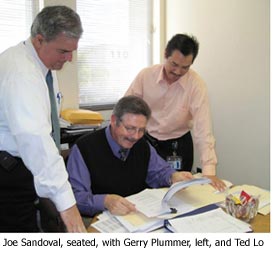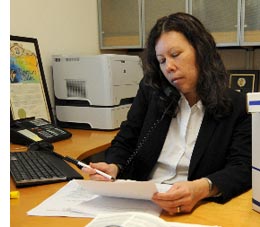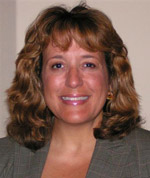The Insider
The $1.8 million office supply diet
February 9, 2010
 Somewhere out there in the vast universe of Los Angeles County office supplies, a Mini-Jeweleria brown resin fountain pen ($40.50) is feeling the heat right about now.
Somewhere out there in the vast universe of Los Angeles County office supplies, a Mini-Jeweleria brown resin fountain pen ($40.50) is feeling the heat right about now.
So is the Victor 12-Digit Heavy-Duty Two-Color Printing Calculator ($202.46), the Deflect-O® Execumat Heavy-Duty Vinyl Chairmat For High-Pile Carpets ($131.54) and a certain aluminum beveled edge ruler ($4.75). All have been purchased by various departments in favor of far cheaper versions of similar products available through the county’s massive office supplies contract.
No more. As county belt-tightening shifts into high gear—and nearly a year after departments were originally asked to switch to cheaper office supply alternatives—the Chief Executive Office is getting ready to draw a line in the supply closet. And not with some expensive gel ink rollerball pen, either.
Led by Joe Sandoval, the county’s general manager of Purchasing and Contract Services, a team of Internal Services Department employees has been going line-by-line through 18,000 items currently offered as purchase options under the county’s Office Depot contract. The goal is to establish a narrower range of reasonably-priced items in a “formulary” that employees will be required to use when ordering supplies. (See graphic below).
Sandoval says he is not fixated on price as the only consideration. “A 12-cent pen is better than a 5-cent pen,” he acknowledges. But he says that having too many choices of writing implements can lead to some bad decisions.
As for who’s buying $18.63 scissors when there are $1.37 scissors to be had, Sandoval prefers not to name any supply scofflaws. “I don’t want to hang any departments out,” he says.
The interest in reining in the county’s $6 million-a-year office supply habit comes against a backdrop of a countywide push for greater efficiency in a tough economy. A pilot program was launched last year, for example, to use remanufactured toner cartridges, saving $23,847 and prompting a countywide switch to such cartridges for black and white desktop printers and copiers.
There’s also an insider’s website tracking efforts to save money and streamline operations across a wide range of departments. The site features an employee suggestion box, which has attracted 238 entries since October.
As for office supplies, the buy-cheaper memo from county CEO William T. Fujioka last March made the case that simply purchasing less expensive pens could yield a savings of $162,000 a year. A purchasing bulletin issued shortly after provided guidance on the right price point on dozens of items—from butterfly clamps and erasers to rubber bands and steno pads.
But a Jan. 25, 2010, memo from Fujioka announcing the formulary plan pointedly noted the “need for greater departmental attention to purchasing low cost office products.”
Sandoval estimates that the county has saved about $500,000 on supplies in the past 12 months. But he thinks it can do so much better.
“We’re looking at a 30% savings when we complete the 18,000 line items,” he says. “That’s a significant savings.” (A cool $1.8 million a year, in case you don’t have your county-approved calculator handy.)
“It’s the best bang for the taxpayer’s buck—that’s the philosophy,” says Sandoval, 52, a 19-year ISD employee and former member of the Air Force’s security police. “That’s what I’m here for.”
He will allow that out there in “Departmentland,” people can be so focused on their “core businesses” that adopting thrifty purchasing habits is not necessarily their highest priority.
And that’s where the new online formulary comes in.
The work on the project—by a team including Gerry Plummer, division manager of purchasing, and Ted Lo, purchasing and contract analyst—should be finished within the next month or so.
When the 9,000 or fewer approved supplies are listed, catalog-style, in the county’s “procurement module,” anyone who goes in to order will see a pull-down menu of just the right choices—not the extravagant ones.
“They won’t be able to see that $32 pen,” Sandoval says.
Fixer-uppers nothing new for no-nonsense housing boss
January 11, 2010
 When Sean Rogan took the top job at the county’s Community Development Commission and Housing Authority in May, its long troubled Section 8 rental housing program was on the comeback trail.
When Sean Rogan took the top job at the county’s Community Development Commission and Housing Authority in May, its long troubled Section 8 rental housing program was on the comeback trail.
But the new executive director quickly let staffers know that just bringing the rental subsidy program back to par wasn’t good enough.
With a mandate by the Board of Supervisors he quickly set about transforming the county’s Section 8 program so that it would be deemed a “high performer” by the federal government, entitling the county program to save money and earn greater autonomy in meeting federal requirements.
High goals and impatient determination are hallmarks for Rogan, 47, who cheerfully calls himself a “Type A personality.”
“I find the challenge of taking a troubled program and turning it around extremely satisfying,” says Rogan, who shows up for work most mornings at 6:30. “While we’ve made great strides in the six months I’ve been here, I’m not going to be satisfied until we are a high-performing agency.”
To better understand the Section 8 program, click here for a primer.
Rogan took the L.A. job after serving as deputy director of Oakland’s Housing & Community Development department, where he worked to repair home ownership and rehabilitation loan programs. His former boss called Rogan a stable influence at the once-troubled agency. Rogan worked under six directors in four and a half years.
“He’s very smart,” says Walter Cohen, Rogan’s last supervisor in Oakland. “He expects performance, and sometimes you don’t make yourself popular by setting the bar high.”
At the CDC, Rogan leads 650 employees and manages an annual budget of half a billion dollars. The CDC is a wide-ranging organization that runs the county’s Housing Authority as well as its economic redevelopment programs.
But it was the $230 million Section 8 program that, before Rogan’s arrival, had gotten all the negative attention.
The Section 8 program subsidizes rent payments to over 20,000 low income families and individuals in unincorporated L.A. County and 62 cities, funneling federal money from the federal Department of Housing and Urban Development to private landlords through a voucher system.
The county’s major administrative job is to find qualified renters. Staffers must inspect each unit annually for safety and other factors and calculate the proper rent subsidies. And they must keep as close to 100 percent of the vouchers in use as possible.
That’s exactly what the county wasn’t doing well. In 2006, HUD officials declared the program “troubled” after reviews and audits discovered that the staffers were failing to accurately inspect each rental unit and verify each client’s financial qualifications on a timely basis, as required.
Worse, more than 15 percent of the vouchers allotted to the county weren’t being handed out.
As a result of the mismanagement, HUD levied a $1 million penalty against the county program and demanded fixes. The previous executive director replaced the Section 8 director and began making strides to correct the problems by, among other things, speeding up inspections and making sure more vouchers were distributed to renters. The Board of Supervisors, demanding that the shortcomings be fixed, allocated extra resources and met with HUD officials to negotiate a corrective action program.
Last July, just weeks after the program earned its highest score ever from regulators, the program’s “troubled” rating was lifted for the first time since 2006.
“The lion’s share of the credit” for the turnaround, Rogan says, should go to CDC staffers and executives who oversaw the improvements. They include: Dorian Jenkins, now assistant executive director for CDC’s Housing Authority; Maria Badrakhan, director of the Housing Management Division, and Margarita Laras, director of the Assisted Housing Division.
Rogan now wants the program to win HUD’s “high-performer” rating by 2011. To do that, he believes he needs to institute cultural and practical changes.
In hiring, he’s ending a perception of “social promotions” in which agency managers were seen as elevating favored employees without interviewing potential competition. Now, he says, all vacancies are posted in an effort “to increase transparency and competition.”
He’s also pushing managers to road test new ideas or policies with their staffs before implementation. “A good idea is a good idea,” he says. “It doesn’t have to come from the top.”
Then there are the culture changes. Traditionally, Section 8 tenants weren’t penalized when they missed appointments for home inspections or did not submit timely “re-exams” of their finances to show they remained eligible.
Such delays wasted time and money. So this fall, Rogan and his staff imposed a requirement that tenants who don’t fulfill their obligations must attend a counseling class. Those who miss a second inspection appointment or a “re-exam” deadline may lose their vouchers.
“If you aren’t going to follow the rules, then—guess what?—there’s a person right behind you who will,” he explains. Rogan says “hundreds” of clients have been attending the classes.
Outside the office, Rogan has had his challenges, too.
Married with two children, he moved to a house in La Canada in August. No sooner was his family settling in than the giant Station Fire swept through the mountains above town. His neighborhood wasn’t immediately threatened, but the smoke and ash billowed so thickly that it proved to be a health risk for his asthmatic daughter.
Rogan moved the family to a friend’s home for four days. Still, months later, Rogan says reminders of the fire persist. Gusty winds still kick up ash and dust that just won’t go away.
But when it comes to the Housing Authority, his home-away-from-home, Rogan is confident the dust is finally settling.
Ordin slated to become first woman county counsel
December 10, 2009
Andrea Sheridan Ordin, one of Los Angeles’ biggest legal names, who has served as a pioneering federal, state and local prosecutor, is poised to become L.A. county’s top lawyer.
Next Tuesday, the Board of Supervisors is expected to hire Ordin as its next County Counsel—the first woman to hold the position. She would oversee a staff of more than 250 lawyers who provide a diverse range of legal services to the supervisors and county departments.
 Ordin, at a salary of $295,000 a year, would replace acting County Counsel Robert Kalunian, who took the position on temporary basis in April, after the retirement of the long-serving Raymond Fortner.
Ordin, at a salary of $295,000 a year, would replace acting County Counsel Robert Kalunian, who took the position on temporary basis in April, after the retirement of the long-serving Raymond Fortner.
For Ordin, currently vice chairman of the Los Angeles Police Commission, the L.A. County position would represent the latest in series of high-profile, and sometimes groundbreaking, government jobs.
Back in the mid-1970s, then-District Attorney John Van de Kamp named Ordin as the first female assistant district attorney, the office’s third highest job.
In 1977, President Jimmy Carter named Ordin as U.S. Attorney for the Central District of California, based in Los Angeles, where she also was the first woman to hold that post. She served for four years, supervising all of the office’s criminal and civil litigation.
In 1983, Van de Kamp, who was then California’s attorney general, tapped Ordin again, this time as chief assistant attorney general, where she oversaw litigation regarding civil rights, antitrust, consumer and environmental litigation. She served in that office until 1990.
“She’ll call them straight,” Van de Kamp said Thursday. “She’ll give you her best judgment as to what the law is regardless of partisan politics.”
Ordin also has been deeply involved in oversight of the Los Angeles Police Department. In the wake of the 1992 Los Angeles riots, she was named to the Christopher Commission, which investigated the factors that led to the beating of Rodney King and subsequent uprising.
Christopher, reached for comment on Thursday, said in a statement: “Andrea Ordin has demonstrated a deep commitment to public service throughout her entire career, and with her deep knowledge of Los Angeles and fine legal skills, she will be a great asset to the County.”
In the book “Official Negligence,” author Lou Cannon credited Ordin with the decision to include blatantly bigoted and sexist police e-mail messages in the Christopher Commission’s report to help better capture the department’s internal culture and keep “the report from being an overly dry statistical analysis.”
In 2005, Los Angeles Mayor Antonio Villaraigosa appointed Ordin to the Police Commission, the five member civilian board that oversees LAPD policy and practices.
Currently, Ordin is a litigation partner at the firm of Morgan Lewis, where she practices in state and federal courts. Her legal practice there is focused on environmental and business litigation as well as appellate work before the 9th Circuit Court of Appeals.
Newly hired planning director ready for big challenges
December 8, 2009
Richard Bruckner, who for the past 10 years has been Pasadena’s director of planning and development, on Tuesday was named Los Angeles County’s director of regional planning.
When he starts work Feb. 1, Bruckner will become the key architect of revamping the county’s general plan—a document that will chart the course for how Los Angeles County will look and function for generations to come.
Bruckner said his biggest challenge in his new post will be dealing with new state legislation on climate change—an effort that will require the close alignment of land-use and transportation planning decisions. He said the county job presents “the challenge of diversity and scale.”
“It’s certainly a step-up in scope,” he said.
“His experience in Pasadena over the past 10 years has been tremendous,” said Katherine Perez, executive director of the Urban Land Institute’s L.A. District Council. She credited Bruckner, who is one of two public sector members of the institute’s executive committee—with the skillful implementation of Pasadena’s general plan.
“It’s Richard’s nature to be collaborative. It’s Richard’s nature to work in partnership,” Perez said, adding that he was skillful in bringing together diverse constituencies such as community stakeholders, business developers and transit planners in Pasadena.
He also has a broad network of relationships in planning and redevelopment circles across the state and commands respect because of Pasadena’s reputation as a well planned city in which community-driven processes play a big part.
Pasadena Mayor Bill Bogaard said Bruckner has been “highly influential in the city’s planning and development” over the past decade, and said he had deftly handled development and community implications of the Gold Line light rail coming to town.
As for high points of his Pasadena tenure, Bruckner pointed to accomplishments such an ordinance requiring developers to provide moderate- and low-income housing; updating plans to integrate housing and transportation in the city’s Old Pasadena and Lake Avenue districts, and setting aside 20 acres of “very important hillside habitat” in Annenberg Canyon.
The county position has been open since the departure of Bruce W. McClendon about a year ago.
As the county’s chief land use planner, Bruckner will earn $210,000 annually. His hiring was recommended by Los Angeles County Chief Executive Officer William Fujioka and approved by the Board of Supervisors.
Giving new meaning to pet projects in government
November 3, 2009
The leggy young thing seemed a bit nervous, even though she looked great—impeccably groomed, hot pink bandana around her neck. She was accompanied by a couple of handlers to stage-manage every step of her debut performance.
She shook ever so slightly as she waited for a photographer in the VIP parking lot. Eventually, she managed to nibble a few greens, and then—paging TMZ!—she urinated! In public! Right there on the grass!
“It’s always a new adventure,” says Evelina Villa, Los Angeles County’s puppy wrangler, as she scooped up young Madeline, the eight-week-old shepherd mix, who was the day’s star attraction, and headed into the Hall of Administration.Ordinarily, Villa, 24, tends to administrative responsibilities in the Long Beach headquarters of the Department of Animal Care & Control. But most Tuesdays, she goes to The Show—the Board of Supervisors meeting. There, she hands off the animal to Supervisor Michael D. Antonovich, who says a few words to coax would-be adopters attending the meeting or watching the next night on cable TV. ![]()
But before the big show-and-tell moment, Villa presides over a behind-the-scenes ritual that has become part of the culture of board meeting days, a folksy tradition that seems more Mayberry than metropolis. In all, nearly 650 pets have found homes—hundreds with county employees—since the program was started by Antonovich in 1995.
In fact, Villa starts the search on behalf of each animal at the very top, making the rounds of each supervisor’s 8th floor office. The No. 1 priority is finding a home for a needy pet, whether it’s with a soft-touch chief deputy or John Q. Dog Lover.
So just before 9 a.m. on a recent Tuesday, there was Madeline on the red carpet in Antonovich’s office, where the “shepherd mix’” part of her lineage was being debated. “Looks like a Jack Russell,” someone says, sizing up Madeline’s tan and cream markings—patches over both eyes, white strip down the nose.
As Villa moved among the board offices, sporting her “Travelin’ Tails” tote bag, she kept her spiel going: “Anyone interested in adopting a little puppy today? This is Madeline. She needs a home.”
In Supervisor Gloria Molina’s office, staff assistant Carlos Huezo looked like a soft touch—he’s already gotten one puppy from Villa, a German shepherd-boxer mix named Cougar. But on this day, he passed. “Maybe next time,” he says, adding: “We’ve all adopted here.”
Then it was off to the office of Supervisor Zev Yaroslavsky, where staffers have adopted a number of pets over the years, including Row-Z, a shepherd mix who now lives with chief deputy Alisa Katz.
“What do we have here? Ooh, she’s precious,” coos Regina Marquez, a longtime Third District caseworker who last year adopted Rex, a pug-Pekinese mix.
Next stop: the seventh floor offices of Chief Executive Officer William Fujioka, who bent down and attempted some dog-speak: “Maddy, Maddy, Maddy….Hey, baby….Good girl….”
Somebody offered a Pup-A-Roni snack strip. Then they were off to the 3rd floor, where, at 10:03 a.m., Villa made the handoff to Antonovich. Madeline’s moment in the limelight had begun. And, just as quickly, ended.
“So that was it, 10:05,” Villa said. Villa, who majored in business and theater at Whittier College, finds that her current job requires a bit of both: she handles all the finery of dog presentation—bandanas, collars, tiny T-shirts—and also keeps a spreadsheet on where each animal ends up. So she knows at a glance that a lab mix named Cody, for example, went home with a “relative of BOS.”
She administers a 19-point questionnaire (“Do you have a fenced yard?” “How many hours of the day will this pet spend alone without any supervision?”) to would-be adopters. If there are multiple applicants, Villa stages a drawing, with a co-worker picking the winner. New owners pay adoption fees and spay/neuter charges that range from $30 to $100, depending on the type of pet and the length of time the animal has been in the shelter.
So far, Villa has resisted the temptation to nab one of the prospective adoptees for herself, although she once had a close call with a Shi-Tzu mix named Lady.
On this day, she was accompanied by Daelene Jimenez, an animal control officer from the Baldwin Park shelter, who was learning the ropes. (In addition to showing off the animals, the department wants to showcase the range of occupations it offers at its six shelters, and sometimes sends animal control officers and animal care attendants to the board meetings to present the pets Villa has selected and named.)
For Jimenez, this meant an early wake-up call and responsibility for another crucial part of the Tuesday ritual—giving Madeline a bath. Jimenez also got a crash course in the tricks of the trade, meant to avoid any dogs-gone-wild moments involving elected officials. Rule No. 1: Always start the day with a potty break on the Temple Street lawn.
Soon, some older animals will be getting their star turns, as well.
“The puppies we have no problem adopting; we’re hoping to give exposure to some of the beautiful older pets,” says Villa’s boss, Michelle Roaché, deputy director of the department’s Outreach and Special Enforcement Division. (Cats are sometimes featured, too, but don’t ask Villa to wrangle them. She’s allergic.)
It is a point of pride that “100% of the animals featured, including dogs, cats, rabbits, birds, and a guinea pig have been placed in new homes,” says Antonovich spokesman Tony Bell.
As for Madeline, no county employees stepped up to adopt her during Villa’s rounds. “Usually, if we do have takers, I would know by now,” Villa says before heading back to her office. So if no one from the public steps up either, then Madeline would head to a rescue organization, which would continue the hunt. “Our goal is to get the dogs out of the shelter,” Villa says, “It’ll end up good for her.”
In the 12 months ending July 1, 25,246 of the 45,356 dogs impounded into county shelters found homes—nearly 56%. Those who’d like to adopt can check out the department’s website.
Investigating child deaths–and the system
October 19, 2009
Rose Belda hit the ground floor running.
Working from a basement office in the Hall of Administration, the newly hired chief of the Children’s Special Investigations Unit already had been directed by the Board of Supervisors to examine the deaths of 36 children. With no staff yet, she was doing her own photocopying of case files.
 Belda nodded towards a six-inch stack of confidential files she’d just run off about Lazhanae S., a 13-year-old charge of the Department of Children and Family Services who, in March, was stabbed to death in South L.A. after bolting from a DCFS-monitored foster home. “Here’s my reading for tonight,” Belda said.
Belda nodded towards a six-inch stack of confidential files she’d just run off about Lazhanae S., a 13-year-old charge of the Department of Children and Family Services who, in March, was stabbed to death in South L.A. after bolting from a DCFS-monitored foster home. “Here’s my reading for tonight,” Belda said.
Her workload won’t lighten anytime soon.
The board hired Belda in September as the unit’s lead attorney to investigate deaths and other “critical incidents” of abuse or neglect of children known to have had contact with the Department of Children and Family Services. She’ll advise the supervisors about needed improvements, offering advice about what works and what doesn’t.
Belda will also examine issues of accountability within children’s services, including whether appropriate disciplinary action was taken, as well as whether problems exist within the overlapping responsibilities of various county departments, including DCFS, probation, mental health and health services.
“Some of the system issues that need to be fixed are huge,” she says of her mandate. “They are not going to be fixed by small changes in policy – by adding a word here or there. I wish it were that easy.”
No doubt, Belda’s own work will be under the microscope, too. She begins her job after several high-profile deaths—and numerous critical news stories—have raised troubling questions about county services to kids in trouble.
In July, Dae’von B., 6, was found beaten to death after the boy had complained of abuse to teachers, health care staffers and social workers. His mother’s ex-boyfriend has been charged in the case. In that same month, preschooler Lars S. of Highland Park was decapitated by his mother, who killed herself, just months after county investigators looking into the mom’s mental health declined to remove the boy from her care. And two months later, In August, 19-month-old Jasmine G. died under mysterious circumstances while in county-supervised foster care.
Belda, 49, believes her experience as County Counsel’s legal advisor to DCFS since 2001 will give her an edge in investigating such tragedies. “Being an insider, I’m not coming in cold,” says Belda.
Belda says that, during her early years with the county representing the interests of children in dependency court, she saw up close the harm that can come to youngsters caught up in the system.
“I have a strong recall of a lot the cases that came in when the kids were really hurt,” says Belda. “In other [county] departments, when someone is asleep at the wheel, people don’t die. This is an area where the impact is so immediate and so quick and so swift. The kids can really get hurt…They need good people to step up for them.”
The mother of two teens, Belda lives in Hollywood with her husband, Superior Court Judge Victor Greenberg, who once held a similar post in the 1990s investigating child deaths as an inspector general in the Auditor Controller’s office.
The new post, which pays $193,000 annually, reports directly to the board.
DCFS Director Trish Ploehn called Belda an “excellent selection” and says she doesn’t believe Belda’s direct line to the supervisors will make adversaries out of her investigative unit and DCFS. “Hopefully,” Ploehn says, “the aim of my department, the board and the CSIU are all the same—find out what has gone wrong in tragic cases and find ways to fix the problems.”
Belda, asked whether she’s experienced any obstacles in her investigations so far, made a politic bow toward the cooperation she’s getting from DCFS and other departments.
“I haven’t found any big impediments,” she says. “All of the county departments have been helpful even when they know that I’m sort of targeting them. People have been, if not thrilled, super polite and super responsive. That’s a real positive.”
Merck no match for L.A. County pharmacy director
May 5, 2009
L.A County Pharmacy Director Amy Gutierrez was determined to make pharmaceutical giant Merck & Co. live by its corporate motto: “Where patients come first.”
Merck, she says, was balking at providing free doses of the cervical cancer vaccine Gardasil to uninsured young women no longer eligible to receive the drug through a state administered program.
Gardasil, which has proven to be about 75% effective in preventing cervical cancer, is recommended for women between the ages of 9 and 26. But California offers free vaccines to uninsured women only up to the age of 18. Gutierrez wanted to make sure that no woman would be denied the vaccine because of her age or insurance status.
Merck executives saw it differently.

L.A County Pharmacy Director Amy Gutierrez
“It was an arbitrary decision that I thought was insulting,” says Gutierrez, who’s headed the pharmacy for three years.
Last summer, Gutierrez began pushing Merck hard on the phone and in writing, with help from Dr. Robert Israel, an OB-GYN who oversees women’s health clinics at LAC+USC medical center. She also enlisted the interim chief medical officer of the county’s health services department, Dr. Robert G. Splawn.
In July, the two co-signed a sharply worded letter to Merck, explaining once again the importance of providing Gardasil to uninsured and vulnerable women between the ages of 19 and 26 at county medical facilities. Denying the vaccine to these patients simply because they’re being seen in a public hospital or clinic, they wrote, “is not logical, nor is it consistent with the stated objectives” of Merck’s patient assistance program, to provide vaccines to those who can’t pay.
Not so subtly, the two also reminded Merck that Los Angeles County is a big customer, spending more than $9 million annually on the company’s various drugs.
Still, Merck held fast to its position, saying it was waiting for the results of a pilot program with public agencies in several states before proceeding, a program for which California had not applied. So Gutierrez and her staff decided to turn up the heat, making Merck aware that the county had begun scrutinizing certain big-ticket purchases from the company.
Concerned by the county’s move, Merck executives called to discuss the situation. But the pharmacy director says she told them: “There’s only one item on the agenda that I want to talk about.”
One month later, in mid-December, Gutierrez says she got “a great Christmas present”—an e-mail from a top Merck executive.
“Hello Dr. Gutierrez,” the note began, “I wanted to confirm that we have altered our policy such that public institutions and entities are now eligible to utilize the current Vaccine Patient Assistance Program in the same manner and to the same extent as private institutions and entities.”
Merck’s dramatic shift in policy was not only good news for Los Angeles County but for every county in the U.S., where the vaccine and other designated drugs can now be distributed through public hospitals and clinics.
“I never thought I could do something to change the policy,” says Gutierrez, whose three daughters have all been vaccinated with Gardasil. “But if you have enough persistence, you can pull it off.”
 In February, the county started administering Gardasil through the LAC+USC Healthcare Networks. Dr. Israel, the women’s health expert and a USC professor, says dosages are being provided to about 25 women a month. In the weeks ahead, he says, other county facilities, such as Olive View Hospital, will begin the vaccination program.
In February, the county started administering Gardasil through the LAC+USC Healthcare Networks. Dr. Israel, the women’s health expert and a USC professor, says dosages are being provided to about 25 women a month. In the weeks ahead, he says, other county facilities, such as Olive View Hospital, will begin the vaccination program.
Even then, however, he does not expect the numbers of participants to be large because, for the most part, women between the ages of 19 and 26 who show up at county facilities with gynecological issues already are confronting serious medical problems. For them, he says, the vaccine is down the list of priorities.
“We opened the door,” he says of the vaccine’s availability. “I didn’t expect we were going to kick the door down.”
Health professionals hope that, in the future, there’ll be no need to provide Gardasil in this older age group. The goal, they say, is for the vaccine to be administered to all girls at an early age, before they have sexual intercourse and become vulnerable to strains of the human papilloma virus that cause cervical cancer.
Until then, Gutierrez says, she’ll continue to spread the word. “If we can in any way impact cervical cancer in L.A., we’ve succeeded.”




















 405 bridge work causes a stink
405 bridge work causes a stink
